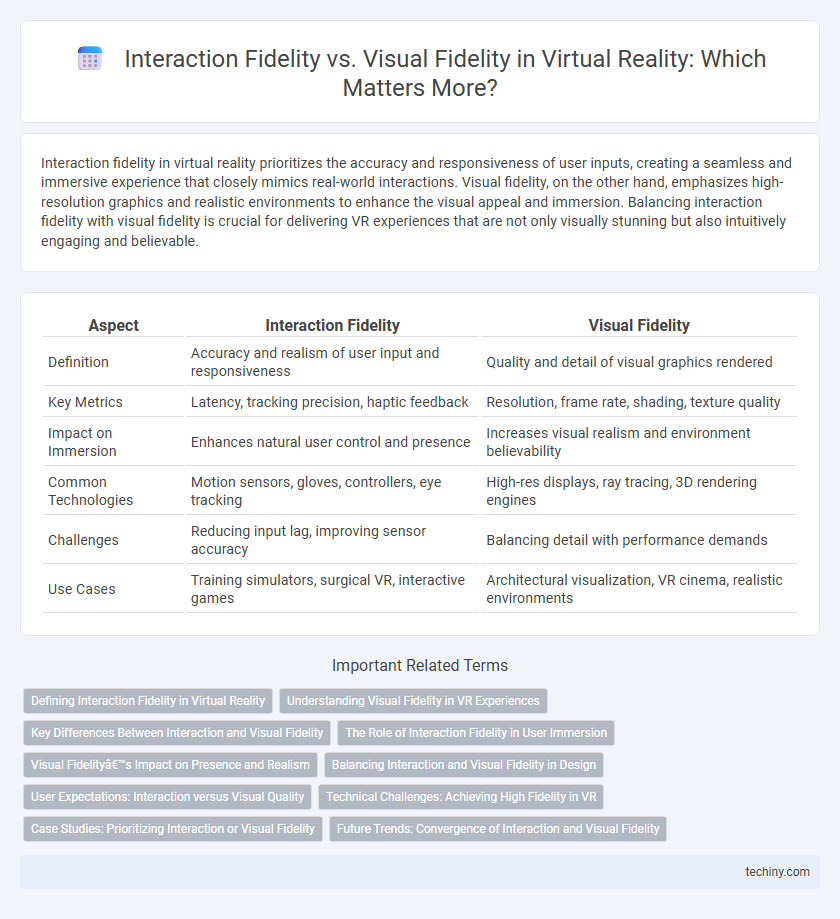Interaction fidelity in virtual reality prioritizes the accuracy and responsiveness of user inputs, creating a seamless and immersive experience that closely mimics real-world interactions. Visual fidelity, on the other hand, emphasizes high-resolution graphics and realistic environments to enhance the visual appeal and immersion. Balancing interaction fidelity with visual fidelity is crucial for delivering VR experiences that are not only visually stunning but also intuitively engaging and believable.
Table of Comparison
| Aspect | Interaction Fidelity | Visual Fidelity |
|---|---|---|
| Definition | Accuracy and realism of user input and responsiveness | Quality and detail of visual graphics rendered |
| Key Metrics | Latency, tracking precision, haptic feedback | Resolution, frame rate, shading, texture quality |
| Impact on Immersion | Enhances natural user control and presence | Increases visual realism and environment believability |
| Common Technologies | Motion sensors, gloves, controllers, eye tracking | High-res displays, ray tracing, 3D rendering engines |
| Challenges | Reducing input lag, improving sensor accuracy | Balancing detail with performance demands |
| Use Cases | Training simulators, surgical VR, interactive games | Architectural visualization, VR cinema, realistic environments |
Defining Interaction Fidelity in Virtual Reality
Interaction fidelity in virtual reality refers to the degree to which a user's physical actions are accurately captured and reflected within the virtual environment, enhancing immersion and presence. High interaction fidelity involves precise motion tracking, realistic haptic feedback, and natural user interfaces that replicate real-world interactions. This contrasts with visual fidelity, which emphasizes graphical realism, as interaction fidelity directly impacts user engagement and the effectiveness of training or simulation applications.
Understanding Visual Fidelity in VR Experiences
Visual fidelity in VR experiences refers to the clarity, realism, and detail of the visual environment, encompassing factors such as resolution, color accuracy, and frame rate. High visual fidelity enhances immersion by making virtual scenes more lifelike and believable, directly impacting user engagement and comfort. Balancing visual fidelity with hardware capabilities and interaction fidelity ensures optimal performance and an immersive, seamless VR experience.
Key Differences Between Interaction and Visual Fidelity
Interaction fidelity in virtual reality emphasizes the accuracy and responsiveness of user inputs and physical feedback, ensuring seamless, natural interactions within the digital environment. Visual fidelity prioritizes the quality of graphical representation, including resolution, texture detail, lighting, and realism of 3D models, to create immersive visual experiences. Key differences lie in interaction fidelity's focus on system responsiveness and haptic feedback versus visual fidelity's concentration on rendering precision and aesthetic immersion.
The Role of Interaction Fidelity in User Immersion
Interaction fidelity significantly enhances user immersion by providing natural, responsive inputs that align with real-world behaviors, enabling users to intuitively manipulate virtual environments. While high visual fidelity contributes to the realism of scenes, it is the precise tracking of gestures, haptics, and spatial audio that deeply anchors users within the VR experience. Studies show that low interaction fidelity often breaks immersion despite photorealistic graphics, underscoring its critical role in maintaining presence and engagement.
Visual Fidelity’s Impact on Presence and Realism
Visual fidelity directly enhances presence and realism in virtual reality by delivering high-resolution textures, accurate lighting, and detailed environments that closely mimic the real world. Improved visual fidelity minimizes the brain's cognitive dissonance, allowing users to feel genuinely immersed and emotionally connected within the virtual space. Studies show that higher visual fidelity significantly increases user engagement and can reduce simulator sickness, boosting overall VR experience quality.
Balancing Interaction and Visual Fidelity in Design
Balancing interaction fidelity and visual fidelity in virtual reality design is critical for creating immersive experiences that feel natural and engaging. High interaction fidelity ensures precise, responsive user inputs, enhancing presence and usability, while strong visual fidelity improves realism and emotional impact. Designers must optimize both to achieve seamless integration where realistic visuals complement intuitive interactions, avoiding compromises that degrade overall immersion.
User Expectations: Interaction versus Visual Quality
User expectations in virtual reality prioritize interaction fidelity over visual fidelity, emphasizing responsive and intuitive controls that enhance immersion. When users experience seamless hand tracking, tactile feedback, and accurate motion sensing, the sense of presence significantly improves despite moderate graphical quality. High visual fidelity without corresponding interaction quality can lead to disengagement, as users value natural and immersive experiences more than photorealistic visuals alone.
Technical Challenges: Achieving High Fidelity in VR
Achieving high interaction fidelity in virtual reality remains a significant technical challenge due to the need for precise motion tracking, low latency, and realistic haptic feedback, which are crucial for immersive user experiences. Visual fidelity demands advanced rendering techniques, such as real-time ray tracing and high-resolution displays, to deliver photorealistic environments without compromising performance. Balancing these aspects requires optimizing hardware-software integration to minimize motion sickness while maintaining synchronization between visual and interaction inputs.
Case Studies: Prioritizing Interaction or Visual Fidelity
Case studies in virtual reality reveal that prioritizing interaction fidelity enhances user engagement by providing realistic tactile feedback and intuitive controls, essential for training simulations and therapeutic applications. Visual fidelity, while important for immersive aesthetics, often takes a secondary role when accurate interaction drives task performance and user satisfaction. Projects like surgical VR training emphasize precise tool manipulation over hyper-realistic graphics, demonstrating that higher interaction fidelity can significantly improve learning outcomes.
Future Trends: Convergence of Interaction and Visual Fidelity
Future trends in virtual reality emphasize the convergence of interaction fidelity and visual fidelity, aiming to create immersive environments where precise user input seamlessly matches hyper-realistic graphics. Advances in haptic feedback, motion tracking, and eye-tracking technologies are driving this fusion, enhancing the authenticity and responsiveness of virtual experiences. Enhanced synchronization between sensory input and visual output is expected to revolutionize applications across gaming, training, and remote collaboration.
interaction fidelity vs visual fidelity Infographic

 techiny.com
techiny.com